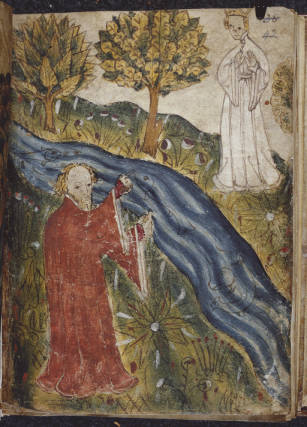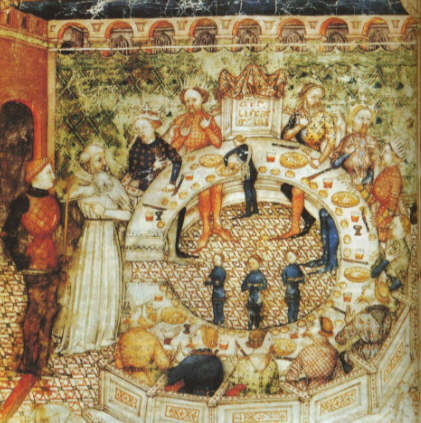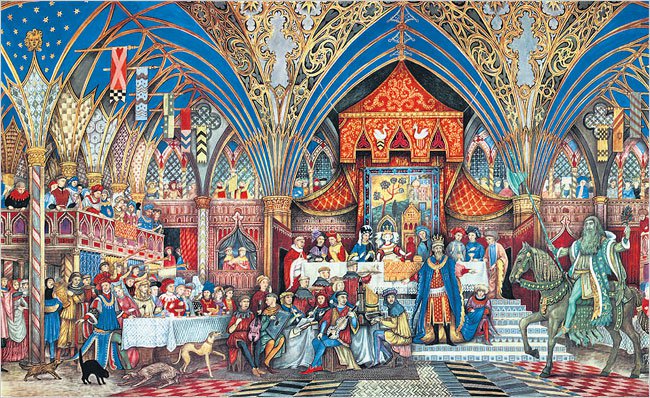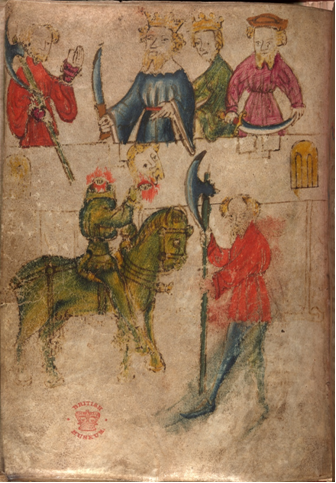[This post, part of an effort to merge our undergraduate and graduate blogs, was written in response to an essay prompt for Kathryn Kerby-Fulton's undergraduate course on "Chaucer's Biggest Rivals: The Alliterative Poets." It comes from the former "Medieval Undergraduate Research" website.]
Marie Borroff is widely considered to be the best American poetic translator of Middle English. I was skeptical of her translation abilities when I first read her modern English versions of Pearl and Sir Gawain and the Green Knight because she did not maintain the rhyme scheme as perfectly as the original, nor the alliteration. However, having attempted my own “modern English” poetic translation of Pearl, I now recognize Borroff’s tremendous skill. I attempted to translate the first two stanzas of section III (lines 121-144) of Pearl. I began by reading over the original text, provided on pages 60-61 of The Poems of the Pearl Manuscript, and translated word by word – with help from the glossary in the back of the book. When the glossary failed to illuminate the meaning of the verses, I consulted Andrew and Waldron’s prose translation. I chose to keep the twelve line stanzas and the grammar of the original, but lost the rhyme, alliteration and rhythm. Here is my translation:
In the beloved splendor of hill and valleys,
Of wood and water and fine plains,
Where I dwelled in bliss, my sorrow abated,
My stress quelled, my pains destroyed.
Down along a stream that continually flows
I went blissfully, my heart brimming with joy*;
The farther I followed those stream-filled valleys,
The greater my joy strained my heart.
As Fortune goes where she tests a person,
Whether she sends someone solace or sorrow,
The person who receives Fortune’s will
Always seeks to have more and more of the same.
There was more of prosperity in that scene
Than I could describe even if I had the time,
For a mortal’s heart could not handle
Rejoicing in just one-tenth of such joys.
Therefore I thought that paradise
Was there over the wide bank nearby;
I believed the water was a divide
Between the joy beyond the boundary and myself✙;
Beyond the brook, somewhere or other,
I believed that paradise was situated.
But the water was deep, I dared not wade across it,
And I longed more and more than ever.
*The Andrew and Waldron prose translation writes this as “my brains brimful [with joy]” (3), but I feel the sentiment is better demonstrated by the narrator’s “heart brimming,” rather than his brain.
✙The Andrew and Waldron prose translation writes this as “I supposed that the water was a division between pleasure-gardens laid out beside pools” (4), but I simply cannot find evidence for the word “pleasure-gardens” and therefore stick to my own version.
Here is the original version of the poem, edited by Andrew and Waldron:
The dubbement dere of doun and dalez,
Of wod and water and wlonk playnez,
Bylde in me blys, abated my balez,
Fordidden my stresse, dystryed my paynez.
Doun after a strem that dryʒly halez
I bowed in blys, bredful my braynez;
þe fyrre I folʒed þose floty valez,
þhe more strenghþe of joye myn herte straynez.
As fortune fares þeras ho fraynes,
Wheþer solace ho sende oþer ellez sore,
þe wyʒ to wham her wylle ho waynez
Hyttez to haue ay more and more.
More of wele watz in þat wyse
þen I cowþe telle þaʒ I tom hade,
For vrþely herte myʒt not suffyse
To þe tenthe dole of þo gladnez glade.
Forþy I þoʒt þat paradyse
Was þer over gayn þo bonkez brade;
I hoped þe water were a deuyse
Bytwene myrþez by merez made;
Byʒonde þe broke, by slente oþer slade,
I hoped þat mote merked wore.
Bot þe water watz depe, I dorst not wade,
And euer me longed ay more and more.

I chose to study these two stanzas largely because of the beauty of line 128: “Þe more strenghþe of joye muyn herte straynez.” The dreamer, in these stanzas, experiences his first sense of relief from the overwhelming grief following his daughter’s passing. He writes of the splendid hills and valleys that “bylde in me blys, abated my balez” (line 123), yet the reader never forgets the underlying tragedy of the loss of the dreamer’s daughter. The paradoxical statement that his heart strains with joy captures the narrator’s conflicting emotions – how his heart is torn between joy at the sight of paradise and sadness for his daughter’s death. Describing his heart as “straining” rather than “full” or even “bursting” adds an element of distress to the stanza, and reveals the depth of emotions portrayed. Marie Borroff, however, does not preserve the imagery of the strained heart in her translation. Instead, she writes: “The greater strength did gladness gain” (128). Her version lacks the distress of the original, and fails to present the dreamer’s mixed emotions. Borroff’s diction otherwise maintains the richness and sentiment of the original manuscript – though she translates “bredful my braynez” (line 126) to “with busy brain” for the sake of continuing the rhyme scheme, whereas I think “heart brimming with joy” better captures the essence of the verse. Other than these two instances, however, I believe that Borroff translates the Middle English to modern English quite well in these two stanzas.
Borroff preserves the linking words as well as the layout of the original poem, with twelve verse stanzas. She mostly maintains the same rhyme scheme as well. Every stanza in the original Pearl rhymes according to the pattern ababababbcbc; Borroff’s translation of the first stanza of part III maintains this pattern brilliantly. Her translation of the second stanza, however, breaks with the rhyme scheme twice, on lines 133 “prize” and 136 “joy”. The rupture of the rhyme scheme is somewhat disorienting, but given the difficulty of updating the language and keeping the rhyme, I understand that Borroff could not make it impeccable. Many scholars argue that the original poem maintains such a tight rhyme scheme because the author used this meticulousness to cope with his grief; perhaps Borroff could not achieve the same level of perfection because of a lack of drama in her personal life.
I argue, however, that Borroff’s sudden break from the rhyme scheme actually preserves the tone of the original poem. Though the poet of the original Pearl keeps the rhyme scheme throughout, there is a dramatic shift in alliteration between the first and second stanzas of part III: the first stanza contains several instances of three and even four alliterative stresses within a verse, whereas the second stanza contains only four verses with three alliterative stresses. This establishes a disconcerting effect to the rhythm: the first stanza skips along pleasantly, with verses like “The dubbement dere of doun and dalez” (121) and “I bowed in blys, bredful my braynez” (126). In the second stanza this quick, lighthearted rhythm halts, becomes disjointed, with lines like “þen I cowþe telle þaz I tom hade” (134) and “I hoped þe water were a deuyse” (139). Though I found four verses with three alliterative stresses (133, 137, 140, and 143), these serve as a reminder of the poet’s ability to alliterate, and reinforce the lack of alliteration within the other lines of the stanza. The alliteration – or lack thereof – reflects the tone of the stanzas. In the first stanza of part III, the poet describes the alleviation of his grief, and hence the alliteration mirrors the joyful scene. In the second stanza, the alliteration reduces significantly, in correspondence with the change in tone: the narrator realizes that he cannot explain paradise, because the mortal heart cannot handle the joy he saw. Furthermore, the narrator wants desperately – “more and more” (144) – to cross the brook and enter paradise, but he cannot. The second stanza, therefore, discusses the narrator’s dashed dreams and awareness of his incapacities – to enter paradise or even describe it – and the reduction of alliteration reflects this gloomy turn. Therefore, when Borroff misses two rhymes in her translation of the second stanza of part III, the rupture coincides with the tone of the original poem: it expresses the idea that something has gone wrong for the narrator, that he is no longer skipping along full of hope and optimism.
Since the original Pearl contains such dramatic four-stress lines, with three or four alliterative stressed syllables, I also decided to analyze Borroff’s treatment of these alliterations in her translation. Like the original version, Borroff provides more alliteration in the first stanza than in the second. Sometimes Borroff maintains the same alliterative sound as the original – such as updating “Of wod and water and wlonk playnez” (122) to “Were wood and water and shining plain” – therefore preserving the alliterative “w” stress. In other instances, she changes the sound but maintains the strong alliteration – for instance, she takes “Bylde in me blys, abated my balez” (123) and transforms it into “My pleasures multiplied apace” with the alliterative “p” stress instead of “b”. Though Borroff provides a decent amount of alliterative stresses, she does not achieve the same amount of skillful alliteration as does the original poet. I’m forced to conclude that, although Borroff’s translation is indeed an accomplishment, her work still falls short of the original version; not because of Marie Borroff’s own shortcomings, but rather because of the mastery exemplified by the original poet in Middle English. The original version of Pearl simply cannot be beat.
Elizabeth Orem
University of Notre Dame




